Types of Vaginal Prolapse
CystoceleUrethroceleRectoceleUterine ProlapseVaginal vaultEnterocele
Normal Anatomy
It is easier to understand uterine and vaginal wall relaxation (prolapse) if one has a working knowledge of normal anatomy. The support system of the uterus, urethra, bladder and to some degree the rectum is the vagina, specifically the "fascia". The vagina is a fibromuscular tube (fascia) covered with vaginal epithelium (skin). It is this fascia which is responsible for the integrity and vaginal wall strength. The fascia is the support system of the vagina. This fascia is elevated and suspended and attached to muscles and ligaments of the pelvis. A simple analogy to the vaginal wall, skin and peripheral attachment is the floor you may be standing upon. The integrity, strength or support (fascia) of the floor is the concrete or wood and the carpet (skin or epithelium) on the support is the vaginal epithelium (vagina skin). The vaginal epithelium (skin) very little support function and primarily acts as a covering.
The floor you are standing, like the fascia, is a complete piece of material which supports anything that sits or stands upon it. The floor, as does the fascia, must be attached to something to give it a point of attachment and further strength. Peripherally the floor is attached to the walls and foundation of the house. Likewise the vagina is attached to certain ligaments and muscles so it remains supportive.
Vaginal and Uterine Support (side view) - Note the upper pubocervical fascia supports the bladder and urethra, the lower rectovaginal fascia supports the rectum. Specifically the rectovaginal fascia keeps the rectum from protruding into the vagina. Both of the pubocervical and rectovaginal fascia attach to the uterus which in turn attaches to the uterosacral ligaments. There is a continuous supportive structure (fascia) from the opening of the vagina to the uterosacral ligaments.
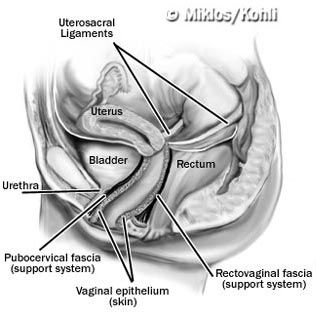
Anterior vaginal wall prolapse (cystocele and urethrocele)
The anterior vaginal wall supports the bladder and the urethra. The anterior vaginal wall supportive layer is called the pubocervical fascia. It is named based upon its two ends of attachment. It is attached distally to the pubic bone area and proximally to the cervix if the uterus has not been removed. The pubocervical fascia is also attached laterally (on both sides) to the pelvic floor muscles specifically the obturator internus muscle. As long as this vaginal wall stays in place the bladder and urethra will stay in its normal anatomical position.
Patients with cystocele or cystourethrocele may experience:
• Pelvic/Vaginal pressure
• Dyspareunia (painful intercourse)
• Dragging or drawing vaginal sensation
• Urinary incontinence
• Difficulty emptying bladder
• Repositioning body to empty bladder
When there is break in the pubocervical fascia there is a loss of support of the urethra and/or bladder resulting in:
Cystocele : Loss of support at the level of the bladder. "bladder drop"
Cystourethrocele : Loss of support of both the urethra and bladder. These two conditions most commonly coexist.
Urethrocele: Loss of support at the level of the urethra. Can be diagnosed by doing a Q-tip test and often coexists with stress urinary incontinence.
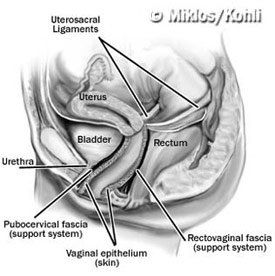
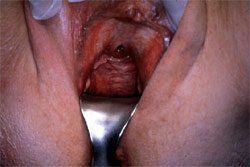
Vaginal and Uterine Support (side view) - Note the upper pubocervical fascia supports the bladder and urethra, the lower rectovaginal fascia supports the rectum. Specifically the rectovaginal fascia keeps the rectum from protruding into the vagina. Both of the pubocervical and rectovaginal fascia attach to the uterus which in turn attaches to the uterosacral ligaments. There is a continuous supportive structure (fascia) from the opening of the vagina to the uterosacral ligaments.
Normal support - as seen on vagina inspection
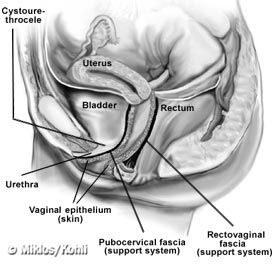

Cystourethrocele - is a combined "cystocele" and "urethrocele" in other words there is a loss of support for the whole anterior vaginal wall. The main supportive layer known as the pubocervical fascia is no longer supporting the bladder or urethra appropriately.
Cystourethrocele - as seen on vagina inspection
To better understand the lack of bladder and urethra support, we need to appreciate the support of those organs by viewing them from an aerial view (i.e. looking downwards on the vagina). Normal support shows the pubocervical fascia (support system of the anterior vaginal wall attached to the arcus tendineus (a tough canvas-like material overlying the muscles) on the pelvic side wall.


Vaginal and Uterine Support (side view) - Note the upper pubocervical fascia supports the bladder and urethra, the lower rectovaginal fascia supports the rectum. Specifically the rectovaginal fascia keeps the rectum from protruding into the vagina. Both of the pubocervical and rectovaginal fascia attach to the uterus which in turn attaches to the uterosacral ligaments. There is a continuous supportive structure (fascia) from the opening of the vagina to the uterosacral ligaments.
Anterior Vagina Normal Support - (aerial view) The bladder and urethra sit on the pubocervical fascia. The pubocervical fascia is attached laterally to the arcus tendineus on both sides.
If there is a break in the pubocervical fascia anywhere throughout its length or at its attachment to the arcus tendineus it will result in a lack of support of the bladder or urethra. A break in the pubocervical fascia (support system) can be in the middle of the fascia (midline defect), apically (where anterior vaginal wall meets the cervix) or laterally (paravaginal defect). Surgical correction of cystocele and urethrocele depend upon the specific area of break:
• Midline defects - site specific repair or anterior repair (colporrhaphy)
• Paravaginal defects - paravaginal repair (MOST COMMON)
• Transverse defects - site specific repair
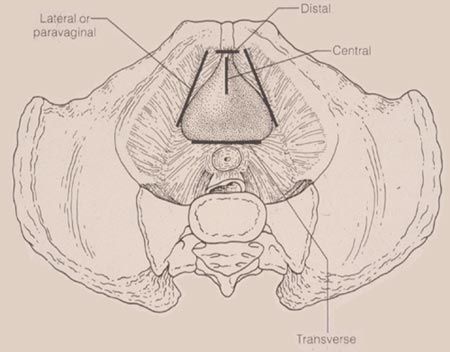
Example of a midline (central) defect: Picture yourself standing in the middle of a room, on a wooden floor which is covered with carpet. Suddenly someone cuts a hole in the wooden floor directly beneath you, leaving the carpet intact. Your feet and body would begin to sag into the hole, but you would not fall through because of the support of the carpet.
This is an example of a midline defect - the bladder falls into the hole or defect of the pubocervical fascia (ie. wooden floor). Now the bladder's only support, in this specific area, is the vaginal skin (carpet). The problem or defect here is not the entire floor, it is only the hole in the floor which is directly beneath you. Therefore this is the area or portion of the pubocervical fascia (ie wooden floor) which needs to be repaired.
The surgical repair of this defect can be seen under "Anterior Repair"
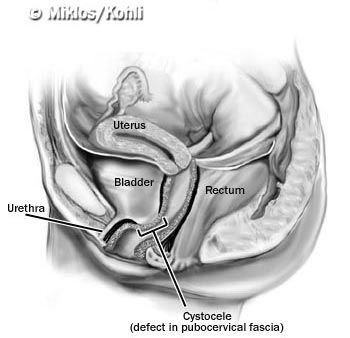

Cystocele midline or central defect - (side view) - This patient has a cystocele due to a midline or central defect on the pubocervical fascia (support system). Now the bladder is sagging in the area lacking fascia. To repair this area an anterior repair should be performed to specifically correct the pubocervical fascia defect.
Cystocele (Midline Defect) - Vaginal View - here the skin has been pulled back to demonstrate the hole or defect in the pubocervical fascia (supportive layer). The defect in the supportive layer allows the bladder to come in direct contact with the vaginal skin resulting in a cystocele.
Example of paravaginal or lateral defect: (MOST COMMON DEFECT) If you were standing on a floor and someone took a saw and cut the attachment of the floor to its wall on each side, the floor would begin to sag. The wooden floor is completely intact without any central or midline defects. Therefore, the problem is not the integrity of the floor directly beneath you, but its attachment to the walls on each side of the room.

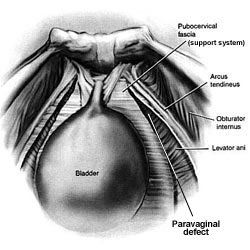
Normal Anterior Vaginal Wall - (aerial view)
Paravaginal (lateral) defect - resulting in a cystocele (aerial view)
Posterior vaginal wall prolapse (rectocele)
The supportive layer of the posterior vaginal wall is called the rectovaginal septum or rectovaginal fascia. It is attached distally to the perineal body, laterally to the levator ani muscle and proximally to the cervix (if uterus is present). When a break in the rectovaginal septum is present the rectal wall will come into contact with the vaginal skin and create a bulge on the posterior bottom side of the vagina. The bulge will usually increase in size with bearing down (Valsalva maneuver) especially when having a bowel movement. Patients with a rectocele may experience:
• Vaginal pressure/discomfort
• Protrusion coming from the posterior vaginal wall
• Difficulty evacuating rectum
• Dyspareunia (painful intercourse)
• Repositioning of body during bowel movements
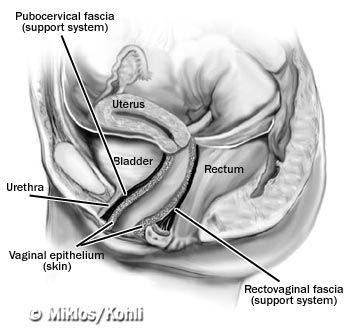
Normal Vagina Support (side view) - The support structure of the posterior vaginal wall is the rectovaginal fascia. Note the continuous nature of the rectovaginal fascia and its flat appearance.

Rectocele (side view) - Note the break in the support structure known as the rectovaginal fascia. A break in the rectovaginal fascia allows the rectal wall to push directly against the vaginal epithelium (skin), thus creating a bulge or a rectocele.
For surgical treatment information, Click here.
Uterine Prolapse
The uterosacral ligaments primarily support the upper 20% of the vagina (apex) and the uterus. When the uterosacral ligaments break the uterus begins to descend into the vagina. Further uterine descension pulls the rest of the vagina down resulting in apical tears of the anterior (pubocervical) fascia and posterior (rectovaginal) fascia from its points of lateral attachment. Anterior vaginal wall lateral tears are called paravaginal defects and results in cystourethrocele. Continued uterine and vaginal prolapse can result in a complete uterine and vaginal prolapse such that the uterus falls outside the vaginal opening and the vagina falls inside out.

Uterine Support (side view) - The anterior vaginal wall (pubocervical fascia) and the posterior wall (rectovaginal fascia) are very supported. Most importantly the uterus is perfectly suspended by the uterosacral ligaments.
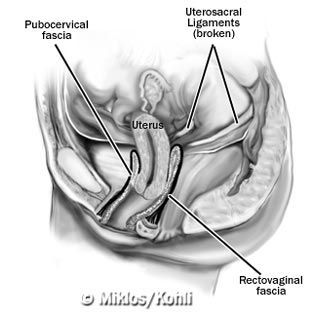
Uterine Prolapse - The uterus begins to prolapse because of the broken uterosacral ligaments.
For surgical treatment information, Click here.
Vaginal Vault Prolapse
Vaginal vault prolapse usually refers to an apical vaginal relaxation in an individual who no longer has a uterus (post hysterectomy). As the apex of the vagina continues to descend it pulls the rest of the vagina down resulting in apical tears of the anterior and posterior fascia from its lateral points of attachment. Continued descent of the vaginal apex may result in complete eversion of the vagina. Complete eversion of the vagina means that the once highest point in the vagina is now the lowest point hanging out of the vagina.
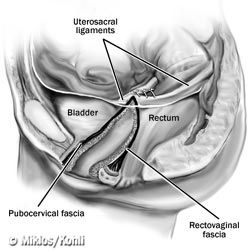

Normal support - vagina apex
Vaginal vault prolapse - Loss of support of the uterosacral ligaments
For surgical treatment information, click here.
Enterocele
Enterocele occur primarily in patients who have had their uterus removed (hysterectomy). The anterior vaginal wall (pubocervical) fascia and posterior vaginal wall (rectovaginal) fascia separate and intestines can push directly against the vaginal skin. The herniation at the apex of the vagina is known as an enterocele.

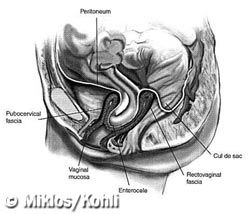
Normal support - no enterocele
Enterocele - There exists a defect between the pubocervical fascia and rectovaginal fascia (note - the intestine are pushing directly against the vaginal epithelium)
Patients with a large enterocele, vaginal vault prolapse and uterine/vaginal prolapsemay experience:
• Pelvic or vaginal pressure
• Difficulty evacuating rectum
• Difficulty emptying bladder
• Dyspareunia (painful intercourse)
• Lower back pain/discomfort
• Increasing pain/discomfort with prolonged standing
• Decreased pain/discomfort upon lying down
• Pain increases as day progresses
For surgical treatment information, Click here.
References:
Reprinted with permission of Atlanta Urogynecology Associates
Copyright © 2000-2003 Atlanta Urogynecology Associates ( www.tvtsling.com )
All text and images on this web site are property of Dr. John R. Miklos and may not be reproduced in any way without permission.
Designed & Developed by Supra International & SBI Inc
FDA approves Visby’s test for at-home STI identification
Published: March 28th 2025 | Updated: March 28th 2025The FDA has approved Visby Medical’s at-home sexually transmitted infection test, allowing women to screen for chlamydia, gonorrhea, and trichomoniasis without a prescription.
Read More
In this episode of Pap Talk, Gloria Bachmann, MD, MSc, breaks down what it means to be a health care provider for incarcerated individuals, and explores the specific challenges women and their providers face during and after incarceration. Joined by sexual health expert Michael Krychman, MD, Bachmann also discusses trauma-informed care and how providers can get informed.
Listen
